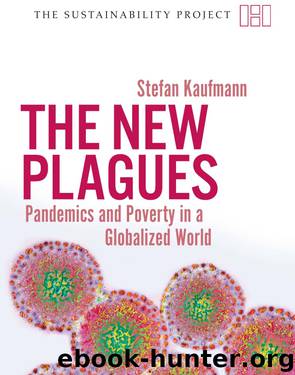The New Plagues by Stefan Kaufmann

Author:Stefan Kaufmann
Language: eng
Format: epub
Tags: Plagues, Sustainability
ISBN: 9781906598600
Publisher: Chicago Distribution Center (CDC Presses)
Protozoa on the march
Many people have heard of sleeping sickness. The causative agent of the disease, a trypanosome, is transmitted to humans by the bite of the tsetse fly in Africa. Trypanosomes are elongated protozoa with a whiplike tail known as a flagellum. They are about the size of a red blood cell. In late stages of the disease patients become emaciated and comatose. Coma often leads to death as the parasite attacks the nervous system. Autoimmune reactions with inflammation of the brain and heart form part of the clinical picture. About half a million people suffer from sleeping sickness and every tenth sufferer dies. A related pathogen, also a trypanosome, is responsible for Chagas disease in Latin America. In this case the vector is an assassin bug of the reduviid family. The most notable effects are on the cardiovascular system, here too due to autoimmune reactions. Here too the mortality rate among the approximately 200,000 people who fall ill with the disease each year is about one in ten. Drugs are available for both diseases, however their side effects are substantial and their effectiveness is limited. Unlike in malaria, mosquito nets are of little use for preventing sleeping sickness, since tsetse flies are active by day. As in the case of the assassin bugs, that leaves open the possibility of using insecticides.
Many neglected tropical diseases disfigure and disable their victims, who become socially excluded as a result. Leishmaniasis is an example of this. The flagellated protozoa that are responsible for this disease are found in Latin America, Africa, and India, and less commonly also in Europe. About 12 million people are infected. Transmission is by the bite of a sandfly. Three forms of leishmaniasis are distinguished. The first is visceral leishmaniasis, also known as kala azar or black fever. Patients with this form of the disease suffer irregular bouts of fever and their immune system fails; if left untreated, most die of opportunistic infections. The second form is cutaneous leishmaniasis. This consists of tropical ulcers and a group of related skin conditions. Near the sandfly bite there appear ulcers that later heal to leave in some cases enormous scars. In mucocutaneous leishmaniasis, the third form of the disease, the infection spreads especially in the mucous membrane of the nose and throat, causing overgrowth of tissue in the throat and destroying the nasal septum. Depictions of such disfigured faces are seen in artifacts dating back to pre-Inca times in Peru and Ecuador. As the depictions concerned date back to the 1st century AD, it is assumed that cutaneous leishmaniasis already existed at that time. A number of drugs, many of which are based on antimony, are now available for the treatment of leishmaniasis, however the results of treatment are not satisfactory. Resistance is increasing and side effects are serious. Another problem is that the vectors are so tiny that they pass through the mesh of standard mosquito nets. The best method of prevention is therefore to kill sandflies using insecticides.
The
Download
This site does not store any files on its server. We only index and link to content provided by other sites. Please contact the content providers to delete copyright contents if any and email us, we'll remove relevant links or contents immediately.
When Breath Becomes Air by Paul Kalanithi(7261)
Why We Sleep: Unlocking the Power of Sleep and Dreams by Matthew Walker(5639)
Paper Towns by Green John(4168)
The Immortal Life of Henrietta Lacks by Rebecca Skloot(3824)
The Sports Rules Book by Human Kinetics(3585)
Dynamic Alignment Through Imagery by Eric Franklin(3487)
ACSM's Complete Guide to Fitness & Health by ACSM(3466)
Kaplan MCAT Organic Chemistry Review: Created for MCAT 2015 (Kaplan Test Prep) by Kaplan(3422)
Introduction to Kinesiology by Shirl J. Hoffman(3299)
Livewired by David Eagleman(3121)
The River of Consciousness by Oliver Sacks(2992)
Alchemy and Alchemists by C. J. S. Thompson(2911)
The Death of the Heart by Elizabeth Bowen(2900)
Descartes' Error by Antonio Damasio(2731)
Bad Pharma by Ben Goldacre(2727)
Kaplan MCAT Behavioral Sciences Review: Created for MCAT 2015 (Kaplan Test Prep) by Kaplan(2491)
The Gene: An Intimate History by Siddhartha Mukherjee(2491)
The Fate of Rome: Climate, Disease, and the End of an Empire (The Princeton History of the Ancient World) by Kyle Harper(2434)
The Emperor of All Maladies: A Biography of Cancer by Siddhartha Mukherjee(2430)
